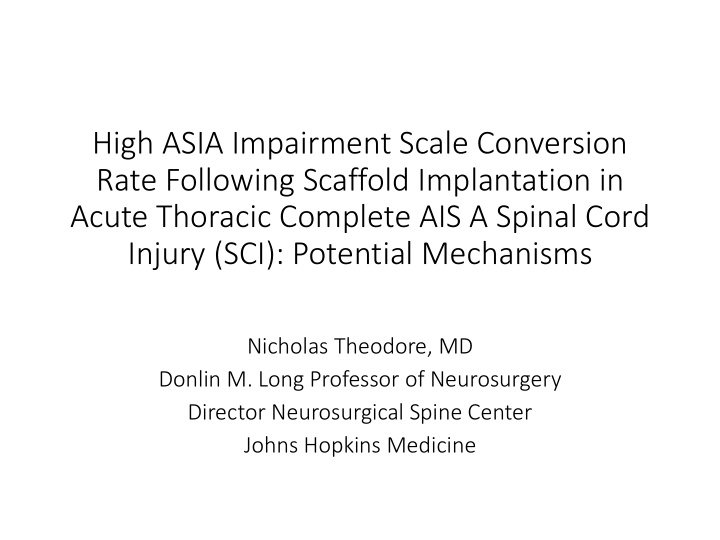



High ASIA Impairment Scale Conversion Rate Following Scaffold Implantation in Acute Thoracic Complete AIS A Spinal Cord Injury (SCI): Potential Mechanisms Nicholas Theodore, MD Donlin M. Long Professor of Neurosurgery Director Neurosurgical Spine Center Johns Hopkins Medicine
Novel Clinical Approach for Acute SCI Treatment: Intraparenchymal Scaffold Implantation • Designed to act as a physical substrate to promote neural repair Porous, bioresorbable device • • In vivo residence time ~4-8 weeks • Intraparenchymal implantation within acute cavity following durotomy and often myelotomy • Investigational device currently being evaluated in INSPIRE clinical trial: NCT02138110 – Currently enrolling baseline T2-T12/L1 AIS A injuries <96hrs
The Scaffold Preserves Spinal Cord Architecture in Pre-Clinical Models Rat Acute Spinal Cord Contusion Injury (at 12 weeks) Neuro-Spinal Scaffold Control Cyst Remodeled Tissue Laminin Cyst Reduction Remodeled Tissue * 6 2.0 Cavity Volume (mm 3 ) P<0.05 Remodeled Tissue 1.5 Volume (mm 3 ) 4 1.0 2 * 0.5 0 0.0 Control Scaffold Control Scaffold Neuro-Spinal Neuro-Spinal Scaffold Scaffold
Neural Regeneration and Remyelination with Schwann Cells after Scaffold Implantation Contusion Injury Epicenter White Matter Central epicenter (a) and white matter (b) Inset: Schwann cells ensheathing axons Rat Acute Spinal Cord Contusion Injury (at 12 weeks) Oligodendrocytes Schwann Cells
The INSPIRE Study - Promising Neurologic Outcomes and Favorable Safety Profile *All Subjects were AIS A at Baseline Time to Age Implant Subject NLI Neurologic Outcome to Date Sex (hr) 25 M 9.2 1 T11 Converted to AIS C at 1 month 2 22 F T7 45.6 Remains AIS A at 12 months 3 56 M T4 82.6 Converted to AIS B at 1 month 4 28 M T3 52.9 Remains AIS A at 12 months 5 18 F T8 69.1 Converted to AIS B at 6 months 21 M 8.8 6 T10 Converted to AIS B at 2 months 25 M 21.3 7 T4 Remains AIS A at 3 months 37 M 40.4 9 T3 Converted to AIS B at 3 months • 5 of 8 evaluable subjects converted from complete to incomplete injuries within 6 months • Natural history reports ~14-16% conversion rate in this patient population
Clinical Benefit of Scaffold Implantation: Potential Mechanisms • Scaffold implantation permits: • Intra-dural decompression • Evacuation of necro- hemorrhagic tissue • Scaffold promotes endogenous tissue remodeling: • Potential cyst reduction – Follow- up MRI’s being assessed Patient 1: 6 month MRI (clinical) • Neural regeneration (pre-clinical) • Promotion of remyelination Laminin by Schwann cells (pre-clinical) β 3-Tubulin Rat Contusion Model
Conclusion and Future Clinical Plans for Scaffold Device • Conclusion • The Scaffold device has demonstrated a favorable safety profile to date in the limited subject population • Preliminary neurological recovery is promising and warrants further clinical investigation • Various clinical mechanisms of action are presented and future advanced studies would be needed to confirm these hypotheses • Future Plans • Continue to enroll acute T2-T12/L1 AIS A to reach 20 evaluable subjects (12 more needed) • 23 clinical sites throughout the U.S. and Canada are currently open • Plan to initiate acute cervical AIS A trial in coming months
Acknowledgements Domagoj Coric, MD Kee Kim, MD Wilson (Zack) Ray, MD Patrick Hsieh, MD Maureen Barry, MD Richard T. Layer, PhD Simon W. Moore, PhD
Recommend
More recommend